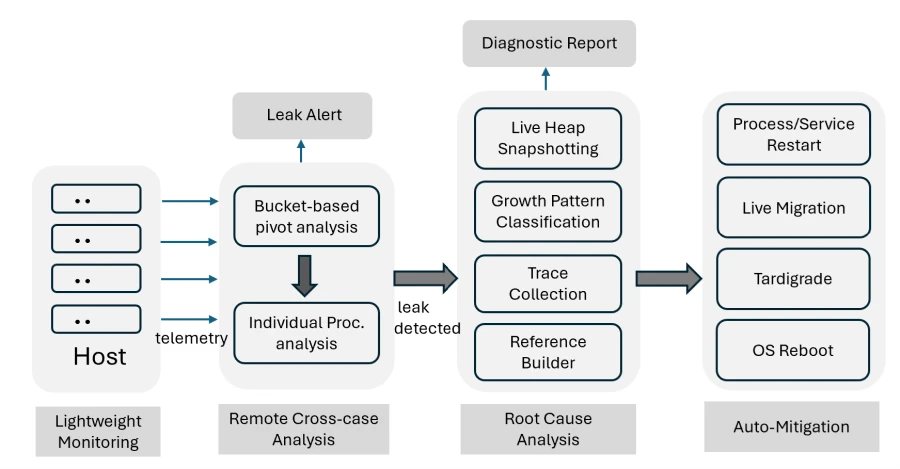“Working a cloud infrastructure at world scale is a big and sophisticated activity, significantly in terms of service customary and high quality. In a earlier weblog, we shared how AIOps was leveraged to enhance service high quality, engineering effectivity, and buyer expertise. On this weblog, I’ve requested Jian Zhang, Principal Program Supervisor from the AIOps Platform and Experiences group to share how AI and machine studying is used to automate reminiscence leak detection, analysis, and mitigation for service high quality.”—Mark Russinovich, Chief Expertise Officer, Azure.
This put up consists of contributions from Principal Information Scientist Supervisor Cong Chen and Companion Information Scientist Supervisor Yingnong Dang of Azure AIOps Platform and Expertise group, Senior Information Scientist Vivek Ramamurthy, Principal Information Scientist Supervisor Ze Li, and Companion Group Software program Engineering Supervisor Murali Chintalapati of Azure Core group.
Within the ever-evolving panorama of cloud computing, reminiscence leaks symbolize a persistent problem—affecting efficiency, stability, and in the end, the consumer expertise. Due to this fact, reminiscence leak detection is necessary to cloud service high quality. Reminiscence leaks occur when reminiscence is allotted however not launched in a well timed method unintentionally. It causes potential efficiency degradation of the part and attainable crashes of the operation system (OS). Even worse, it typically impacts different processes working on the identical machine, inflicting them to be slowed down and even killed.
Given the affect of reminiscence leak points, there are a lot of research and options for reminiscence leak detection. Conventional detection options fall into two classes: static and dynamic detection. The static leak detection methods analyze software program supply code and deduce potential leaks whereas the dynamic technique detects leak via instrumenting a program and tracks the item references at runtime.
Nonetheless, these typical methods for detecting reminiscence leaks usually are not sufficient to fulfill the wants of leak detection in a cloud surroundings. The static approaches have restricted accuracy and scalability, particularly for leaks that end result from cross-component contract violations, which want wealthy area information to seize statically. On the whole, the dynamic approaches are extra appropriate for a cloud surroundings. Nonetheless, they’re intrusive and require in depth instrumentations. Moreover, they introduce excessive runtime overhead which is dear for cloud providers.

RESIN
Designed to handle reminiscence leaks in manufacturing cloud infrastructure
Introducing RESIN
Right now, we’re introducing RESIN, an end-to-end reminiscence leak detection service designed to holistically handle reminiscence leaks in massive cloud infrastructure. RESIN has been utilized in Microsoft Azure manufacturing and demonstrated efficient leak detection with excessive accuracy and low overhead.
RESIN system workflow
A big cloud infrastructure might include lots of of software program elements owned by completely different groups. Previous to RESIN, reminiscence leak detection was a person group’s effort in Microsoft Azure. As proven in Determine 1, RESIN makes use of a centralized method, which conducts leak detection in multi-stages for the advantage of low overhead, excessive accuracy, and scalability. This method doesn’t require entry to elements’ supply code or in depth instrumentation or re-compilation.

RESIN conducts low-overhead monitoring utilizing monitoring brokers to gather reminiscence telemetry knowledge at host stage. A distant service is used to mixture and analyze knowledge from completely different hosts utilizing a bucketization-pivot scheme. When leaking is detected in a bucket, RESIN triggers an evaluation on the method cases within the bucket. For extremely suspicious leaks recognized, RESIN performs reside heap snapshotting and compares it to common heap snapshots in a reference database. After producing a number of heap snapshots, RESIN runs analysis algorithm to localize the foundation reason for the leak and generates a analysis report to connect to the alert ticket to help builders for additional evaluation—in the end, RESIN routinely mitigates the leaking course of.
Detection algorithms
There are distinctive challenges in reminiscence leak detection in cloud infrastructure:
- Noisy reminiscence utilization brought on by altering workload and interference within the surroundings leads to excessive noise in detection utilizing static threshold-based method.
- Reminiscence leak in manufacturing methods are often fail-slow faults that might final days, weeks, and even months and it may be troublesome to seize gradual change over lengthy durations of time in a well timed method.
- On the scale of Azure world cloud, it’s not sensible to gather fine-grained knowledge over lengthy time period.
To deal with these challenges, RESIN makes use of a two-level scheme to detect reminiscence leak signs: A world bucket-based pivot evaluation to determine suspicious elements and a neighborhood particular person course of leak detection to determine leaking processes.
With the bucket-based pivot evaluation at part stage, we categorize uncooked reminiscence utilization into plenty of buckets and rework the utilization knowledge into abstract about variety of hosts in every bucket. As well as, a severity rating for every bucket is calculated based mostly on the deviations and host rely within the bucket. Anomaly detection is carried out on the time-series knowledge of every bucket of every part. The bucketization method not solely robustly represents the workload pattern with noise tolerance but in addition reduces computational load of the anomaly detection.
Nonetheless, detection at part stage solely isn’t enough for builders to analyze the leak effectively as a result of, usually, many processes run on a part. When a leaking bucket is recognized on the part stage, RESIN runs a second-level detection scheme on the course of granularity to slim down the scope of investigation. It outputs the suspected leaking course of, its begin and finish time, and the severity rating.
Prognosis of detected leaks
As soon as a reminiscence leak is detected, RESIN takes a snapshot of reside heap, which accommodates all reminiscence allocations referenced by working utility, and analyzes the snapshots to pinpoint the foundation reason for the detected leak. This makes reminiscence leak alert actionable.
RESIN additionally leverages Home windows heap supervisor’s snapshot functionality to carry out reside profiling. Nonetheless, the heap assortment is dear and may very well be intrusive to the host’s efficiency. To attenuate overhead brought on by heap assortment, a number of concerns are thought of to resolve how snapshots are taken.
- The heap supervisor solely shops restricted data in every snapshot equivalent to stack hint and dimension for every lively allocation in every snapshot.
- RESIN prioritizes candidate hosts for snapshotting based mostly on leak severity, noise stage, and buyer affect. By default, the highest three hosts within the suspected record are chosen to make sure profitable assortment.
- RESIN makes use of a long-term, trigger-based technique to make sure the snapshots seize the whole leak. To facilitate the choice relating to when to cease the hint assortment, RESIN analyzes reminiscence progress patterns (equivalent to regular, spike, or stair) and takes a pattern-based method to resolve the hint completion triggers.
- RESIN makes use of a periodical fingerprinting course of to construct reference snapshots, which is in contrast with the snapshot of suspected leaking course of to assist analysis.
- RESIN analyzes the collected snapshots to output stack traces of the foundation.
Mitigation of detected leaks
When a reminiscence leak is detected, RESIN makes an attempt to routinely mitigate the problem to keep away from additional buyer affect. Relying on the character of the leak, a number of sorts of mitigation actions are taken to mitigate the problem. RESIN makes use of a rule-based resolution tree to decide on a mitigation motion that minimizes the affect.
If the reminiscence leak is localized to a single course of or Home windows service, RESIN makes an attempt the lightest mitigation by merely restarting the method or the service. OS reboot can resolve software program reminiscence leaks however takes a for much longer time and may trigger digital machine downtime and as such, is often reserved because the final resort. For a non-empty host, RESIN makes use of options equivalent to Mission Tardigrade, which skips {hardware} initialization and solely performs a kernel tender reboot, after reside digital machine migration, to attenuate consumer affect. A full OS reboot is carried out solely when the tender reboot is ineffective.
RESIN stops making use of mitigation actions to a goal as soon as the detection engine now not considers the goal leaking.
Outcome and affect of reminiscence leak detection
RESIN has been working in manufacturing in Azure since late 2018 and up to now, it has been used to observe hundreds of thousands of host nodes and lots of of host processes day by day. General, we achieved 85% precision and 91% recall with RESIN reminiscence leak detection,1 regardless of the quickly rising scale of the cloud infrastructure monitored.
The top-to-end advantages introduced by RESIN are clearly demonstrated by two key metrics:
- Digital machine sudden reboots: the common variety of reboots per 100 thousand hosts per day because of low reminiscence.
- Digital machine allocation error: the ratio of inaccurate digital machine allocation requests because of low reminiscence.
Between September 2020 and December 2023, the digital machine reboots had been diminished by almost 100 instances, and allocation error charges had been diminished by over 30 instances. Moreover, since 2020, no extreme outages have been brought on by Azure host reminiscence leaks.1
Study extra about RESIN
You may enhance the reliability and efficiency of your cloud infrastructure, and forestall points brought on by reminiscence leaks via RESIN’s end-to-end reminiscence leak detection capabilities designed to holistically handle reminiscence leaks in massive cloud infrastructure. To be taught extra, learn the publication.
1 RESIN: A Holistic Service for Coping with Reminiscence Leaks in Manufacturing Cloud Infrastructure, Chang Lou, Johns Hopkins College; Cong Chen, Microsoft Azure; Peng Huang, Johns Hopkins College; Yingnong Dang, Microsoft Azure; Si Qin, Microsoft Analysis; Xinsheng Yang, Meta; Xukun Li, Microsoft Azure; Qingwei Lin, Microsoft Analysis; Murali Chintalapati, Microsoft Azure, OSDI’22.